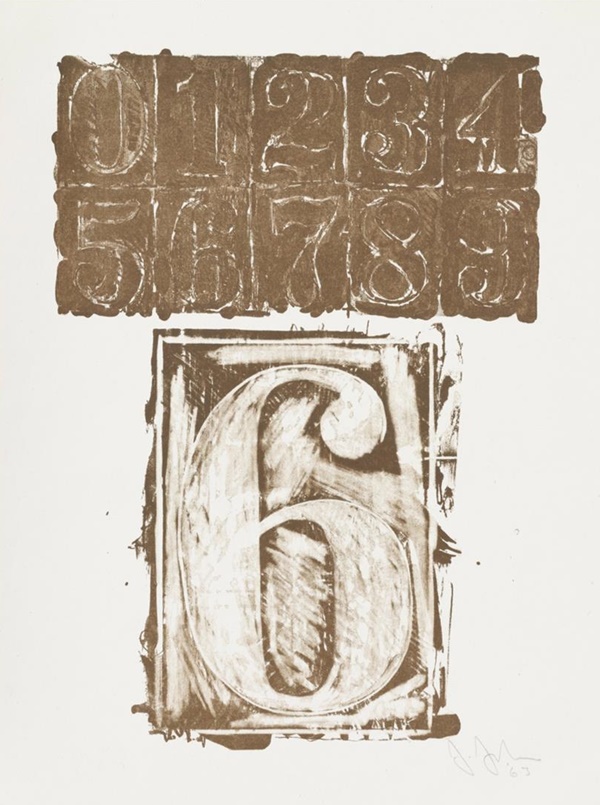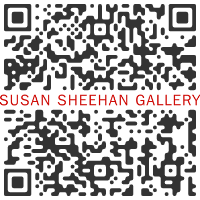"6"
Jasper Johns

SUSAN SHEEHAN GALLERY
136 East 16th Street New York, NY 10003Tel 212 489-3331 Fax 212 489-4009 e-mail:



January, 2021
Jasper Johns, one of America's most important and celebrated living artists, has mastered the many printmaking techniques and frequently returns to the medium. This early lithograph from Johns's 1963 portfolio 0-9 marks the beginning of his lifelong commitment to repeated experimentation by using everyday symbols in his painting, sculpture, and prints.
Johns created his first prints in 1960 at Universal Limited Art Editions (ULAE) on Long Island. Initially drawn to lithography, Johns eventually learned etching, silkscreen, and aquatint, and often used multiple techniques to create a single print. Printmaking enabled Johns to investigate the possibilities of layering, repeating, and obscuring—ideas he was already exploring other mediums—in new, process-driven ways.
That year, Johns created his first lithograph featuring numbers. Titled 0 through 9, the print shows these numbers layered on top of each other, all rendered at the same scale using stencils. Coupled with the title, the printed numerals are simultaneously recognizable and illegible. Johns experimented with layering numbers in this way in drawings, paintings, and various prints throughout the 1960s. It is worth noting, however, that Johns's interest in numbers had begun even earlier, when he created the multimedia collage Construction with Toy Piano (1954), which features a row of stenciled numerals.
In 6, Johns returns to using rows of numerals, with the number 6 below them at a larger scale. Shown isolated rather than layered, 6 lends the number an iconographic quality despite its unremarkable recognizability. As with his use of other quotidian symbols, such as flags and targets, numerals interested Johns because they are "seen and not looked at." Furthermore, by using number stencils, Johns could draw the viewer's attention away from the content of his work and towards his methods and materials. Ironically, the use of stencils for 6 thus highlights the artist's hand by emphasizing the print's tactile qualities.
6 is part of an exceedingly rare portfolio produced in a limited edition of 10. The portfolio comprised individual prints of each number, 0 through 9. Johns drew the numerals on stone using his signature stencils, and then printed 10 complete sets in three different colors: black, gray, and multicolor. This print of 6 comes from the highly sought-after latter edition. When they were first completed, each set was enclosed in a hand-made balsa wood box.
Johns has continually returned to numerals throughout his career, more-so than any other motif. Nearly 70 of his paintings and sculptures feature numbers, in addition to drawings and 25 print editions. In 1979, Johns commented on this repetition by saying: "I like to repeat an image in another medium to observe the play between the two: the image and the medium. In a sense, one does the same thing two ways and can observe differences and samenesses—the stress the image takes in different media." 6 is an important early example of this lifelong interest.
Johns created his first prints in 1960 at Universal Limited Art Editions (ULAE) on Long Island. Initially drawn to lithography, Johns eventually learned etching, silkscreen, and aquatint, and often used multiple techniques to create a single print. Printmaking enabled Johns to investigate the possibilities of layering, repeating, and obscuring—ideas he was already exploring other mediums—in new, process-driven ways.
That year, Johns created his first lithograph featuring numbers. Titled 0 through 9, the print shows these numbers layered on top of each other, all rendered at the same scale using stencils. Coupled with the title, the printed numerals are simultaneously recognizable and illegible. Johns experimented with layering numbers in this way in drawings, paintings, and various prints throughout the 1960s. It is worth noting, however, that Johns's interest in numbers had begun even earlier, when he created the multimedia collage Construction with Toy Piano (1954), which features a row of stenciled numerals.
In 6, Johns returns to using rows of numerals, with the number 6 below them at a larger scale. Shown isolated rather than layered, 6 lends the number an iconographic quality despite its unremarkable recognizability. As with his use of other quotidian symbols, such as flags and targets, numerals interested Johns because they are "seen and not looked at." Furthermore, by using number stencils, Johns could draw the viewer's attention away from the content of his work and towards his methods and materials. Ironically, the use of stencils for 6 thus highlights the artist's hand by emphasizing the print's tactile qualities.
6 is part of an exceedingly rare portfolio produced in a limited edition of 10. The portfolio comprised individual prints of each number, 0 through 9. Johns drew the numerals on stone using his signature stencils, and then printed 10 complete sets in three different colors: black, gray, and multicolor. This print of 6 comes from the highly sought-after latter edition. When they were first completed, each set was enclosed in a hand-made balsa wood box.
Johns has continually returned to numerals throughout his career, more-so than any other motif. Nearly 70 of his paintings and sculptures feature numbers, in addition to drawings and 25 print editions. In 1979, Johns commented on this repetition by saying: "I like to repeat an image in another medium to observe the play between the two: the image and the medium. In a sense, one does the same thing two ways and can observe differences and samenesses—the stress the image takes in different media." 6 is an important early example of this lifelong interest.

 | Jasper Johns |
mpefm
NEW ACQUISITIONS art press release









